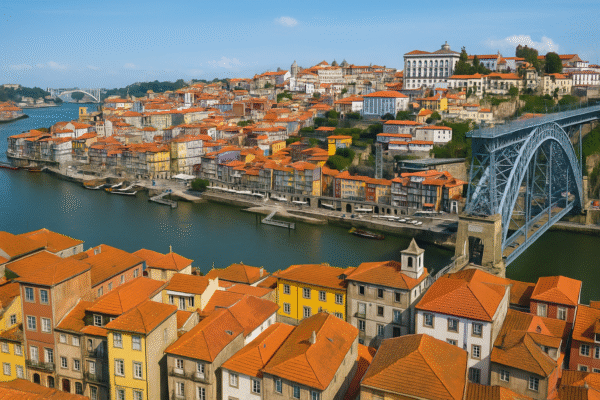Portugal’s tourism landscape is evolving rapidly, as Lisbon and Porto officially join Europe’s top 20 cities with the highest tourist taxes. The move reflects a strategic shift toward managing overtourism, financing urban infrastructure, and aligning with luxury travel demand.
Lisbon currently imposes a tourist tax of €4 per night, while Porto charges €3 per night, placing them in the 16th and 20th spots respectively on the European ranking. These fees apply per person, per night, for up to seven consecutive nights and are exempt for children under 13.
Why Portugal Raised Tourist Taxes
The surge in tourist tax rates is directly linked to the country’s booming tourism industry, which brought in over 30 million visitors in 2023, according to Turismo de Portugal. Both cities have seen mounting pressure on their transportation systems, historical landmarks, and environmental sustainability due to rising visitor numbers.
“Cities like Lisbon and Porto must balance welcoming visitors with preserving urban life and public services,” said Portugal’s Secretary of State for Tourism, Commerce, and Services. A centralized reform to streamline municipal tax disparities is currently under review, aiming to reduce confusion among tourists and optimize revenue use.
Lisbon’s €4 Tax: Boosting Infrastructure and Culture
Since launching its tourist tax in 2016 at €1 per night, Lisbon has steadily increased the levy, most recently doubling it in September 2024. The city now charges €4 per night for all guests in licensed accommodations. In 2024 alone, this tax generated €49.51 million, with cumulative collections nearing €260 million since inception.
A notable expansion came in 2024 with the introduction of a cruise passenger tax. Travelers arriving via cruise ships now pay €2 per person if they are over 13 years old. This initiative aligns Lisbon with other leading cruise ports that are adapting to rising maritime tourism.
Revenues are directed toward enhancing public transport, cultural sites, waste management, and urban sustainability. According to Lisbon City Hall, these funds support projects including electric bus fleets, museum preservation, and waterfront regeneration initiatives.
Porto’s €3 Tax: Managing Growth and Sustainability
Porto, often praised for its wine culture and Douro River charm, implemented its tourist tax in 2018. Initially set at €2 per night, the city raised the rate to €3 in 2024 to cope with increasing tourism-related costs.
From January to April 2025, Porto collected €9.3 million from the tourist tax—an increase of 42% compared to the same period in 2023. The funds are invested in urban maintenance, heritage site conservation, traffic decongestion, and green space development.
City officials have emphasized that these contributions directly support the tourism sector’s longevity, making Porto more resilient to mass travel while improving quality of life for residents.
European Context: Who Tops the Tourist Tax Chart?
While Lisbon and Porto now feature prominently in Europe’s tourist tax rankings, Amsterdam leads the continent with a staggering €18.45 per night charge. This includes a 12.5% hotel tax and additional fixed fees. Other high-tax cities include:
- Athens and Rhodes, Greece – Approx. €8.17 per night
- Berlin, Germany – €7.38 per night
- Rome, Italy – Variable by hotel class, up to €7
These rates reflect the growing use of tourist taxes as tools for sustainable tourism, especially in heritage-rich or environmentally vulnerable destinations.
Public Debate and Future Reforms in Portugal
Despite strong fiscal results, Portugal’s tourist tax system has faced criticism for its lack of standardization. Each municipality sets its own rates and terms, leading to inconsistencies for travelers moving across regions.
Tourism stakeholders and policy advisors argue that Portugal could benefit from a national framework, offering clearer guidelines for implementation, exemption, and reinvestment strategies.
“Tourist taxes must not deter travelers but should enhance their experiences by funding improvements,” noted a spokesperson from Turismo de Portugal. Proposals under discussion include digital collection systems, clearer receipts, and improved transparency in how funds are allocated.
Luxury Travel Trend or Price Barrier?
The inclusion of Lisbon and Porto in Europe’s top taxed cities signals Portugal’s evolution from a budget destination to a luxury contender. With upscale hotel openings, Michelin-starred restaurants, and curated cultural itineraries, the country is appealing to high-spending travelers seeking immersive experiences.
However, travel advocates caution that price-sensitive visitors may shift toward less expensive regions, especially if municipal taxes continue rising without added value.
According to the European Travel Commission, affordability remains a key decision factor for middle-income tourists. As neighboring Spanish and Mediterranean cities adopt similar levies, the region’s competitiveness will depend on transparent communication and perceived value.
Conclusion: Balancing Tourism Growth with Livability
As Lisbon and Porto implement higher tourist taxes, they aim to secure long-term sustainability without compromising visitor appeal. While critics worry about affordability, local governments are positioning these levies as essential tools for enhancing urban services, heritage protection, and ecological balance.
Travelers planning visits to Portugal in 2025 and beyond should budget for nightly tourist taxes and consider how their contributions support the destinations they enjoy. With Lisbon and Porto now among Europe’s costliest cities for overnight visitors, the conversation around responsible tourism and equitable funding is more important than ever.
For more travel news like this, keep reading Global Travel Wire



















